What do bearded dragons eat How often they eat? All bearded dragon diet questions answered!
Bearded dragons are easy to maintain since they eat a diversity of foods as we are going to see.
Understanding what to feed your bearded dragon in the right way is vital to keep them healthy and avoid life-threatening health issues.
To understand about a healthy diet for bearded dragons, you need to know all its constituents- right away from veggies, feeders, fruits, supplements, among others.
In this long article, you are going to understand when and what to feed your bearded dragon. You will also learn many things related to the beardie’s diet. Don’t miss this compelling information; just keep reading.
Contents
- Bearded Dragon Diet List: What Do Bearded Dragons Eat?
- Bearded Dragon Diet In The Wild
- Baby Bearded Dragon Diet
- Juvenile Bearded Dragon Diet
- Adult Bearded Dragon Diet
- Bearded Dragon Feeding Schedule
- Bearded Dragon Diet by Age
- How To Transition A Bearded Dragon To A New Diet
- How Long Can A Bearded Dragon Go Without Food?
- What Not To Feed Your Bearded Dragon
- Wrapping Up Bearded Dragon Diet
Bearded Dragon Diet List: What Do Bearded Dragons Eat?
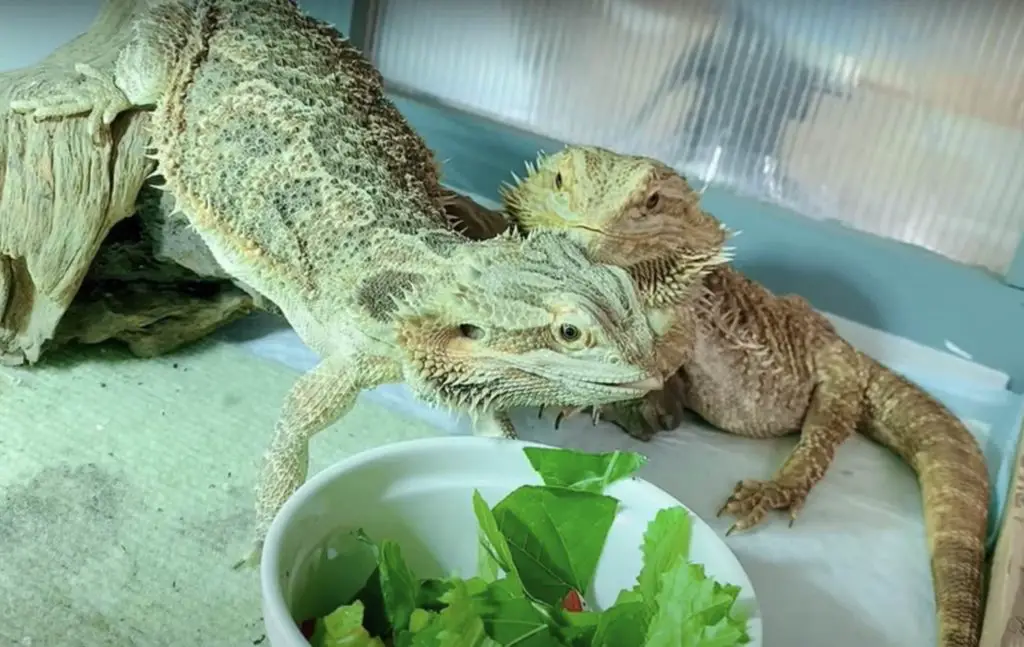
The primary concern after owning a bearded dragon as a pet is what food to give to them. If you are wondering about what food your pet should eat, then you are in the right place.
Bearded dragons are omnivores; they eat different live foods, fruits, vegetables, and leafy greens. We will see all the veggies, greens, fruits, and meat that beardies can safely eat and those that should be avoided.
You need this information for the good of your adorable little friend. Getting to understand what is suitable for your beardie allows you to give what is necessary. Proper feeding enhances good health and the wellness of your pet.
What Fruits Can Bearded Dragons Eat?
Bearded dragons can eat fruits. The fruits should make up the smallest portion in the diet and need to be given occasionally. The beardies gladly munch on different varieties of fruits.
Fruits are a great source of various essential nutrients, such as vitamins, fiber, and minerals. Also, the beardies obtain much of its water from fruits and veggies; this is why the beardies rarely drink water.
There is a big list of healthy fruits that are safe for you to feed your pet. Our diet list tells you safe fruits for the bearded dragons.
- Peeled Apples
- Papaya (pawpaw)
- Guavas
- Watermelon
- Peas
- Red and Green Grapes
- Kiwi
- Strawberries, blackberries, blueberries, cranberries.
- Plums
- Figs
- Apricots
- Seedless Raisins
- Cherries (remove the pit)
- Mandarin oranges
- Canned pineapples and prunes
- Honeydew and Cantaloupe
- Peach.
Beware that some soft fruits such as kiwi are sugary; they can ferment or result in teeth problems. Make sure you give your beardie a tiny portion of soft fruits about one time in a month.
Offering the fruits to your beardie helps it to develop its palette and make the salad more enticing.
What Vegetables Can Bearded Dragons Eat?
Bearded dragons eat a wide variety of vegetables and leafy greens. Veggies are a staple food to the beardies. They are the primary source of vitamins, minerals, water, among others.
You can give veggies freely the way your beardie wants, but make sure you provide the right amounts. Feel free to include the following vegetables and leafy greens in your beardie’s diet.
- Mustard greens
- Okra
- Red and green cabbage
- Arugula
- Turnip greens
- Parsnip
- Raw Kale, Pumpkin, Zucchini, Leeks, and Radish.
- Peeled cucumber
- Collard greens
- Squash (Butternut, Summer, Spaghetti, and Acorn)
- Green, yellow or red Bell Pepper
- Uncooked Artichoke Heart
- Basil
- Bok Choy
- Dandelion greens
- Coriander
- Rocket
- Parsley
What Insects Can Bearded Dragons Eat?
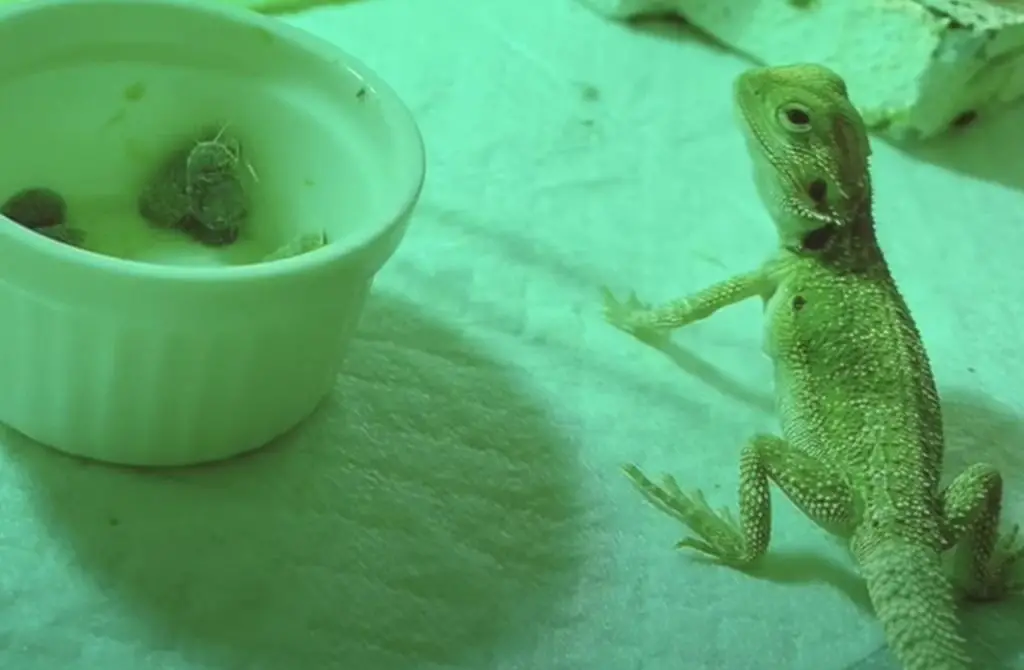
Insects are the primary source of protein to the bearded dragons. Avoid collecting insects from the wild to feed your beardie because they may contain harmful chemicals and parasites. Buy insects from only the sellers that are trustworthy and have a good reputation.
Note that you cannot just give any insect to the babies and juvenile bearded dragons. We will see the ideal insect for both in their specific dietary needs. You can jump down farther to see them.
Our diet list tells you the insects that are safe to feed the bearded dragons.
- Crickets
- Mealworms
- Dubia roaches
- Earthworms
- King worms
- Wax Worms
- SilkWorms
- Super Worms
- Goliath worms (larvae of the Carolina sphinx moth)
- Locusts
- Redworms
- Black soldier fly larvae (Phoenix worms)
- Butterworm
- Cockroaches
Bearded Dragon Diet In The Wild
Since you are in control of what to feed a captive bearded dragon, you need to understand all its food list. What about the wild bearded dragons? What do they eat? It is indeed a good question and is healthy to have such a concern. It shows you truly understand your pet’s origin.
Knowing what beardies consume in the wild helps us to replicate the same to our lovely pets. Now, wild bearded dragons consume small insects like crickets, termites, and spiders; and infrequently feed on small lizards and rodents.
Also, wild bearded dragons are believed to be seasonal foragers. They will forage on a variable amount of greens and flowers they can find. Here are some vegetables wild bearded dragons eat; Alfalfa sprout, Carrots, Collard greens, Dandelion leaves and flowers, Endive, Mustard greens, Arugula, among others.
Wild bearded dragons tend to consume more proteins than they do in captivity. The beardies move more often when hunting in the desert, and in the process, they burn most of the calories. Therefore, they need abundant protein to supply enough energy.
Our captive bearded dragons do not move a lot; if they eat a lot of protein foods like in the wild, it can result in obesity and severe health issues. This is why we need to limit the levels of proteins as much as possible, particularly in adults.
Baby Bearded Dragon Diet
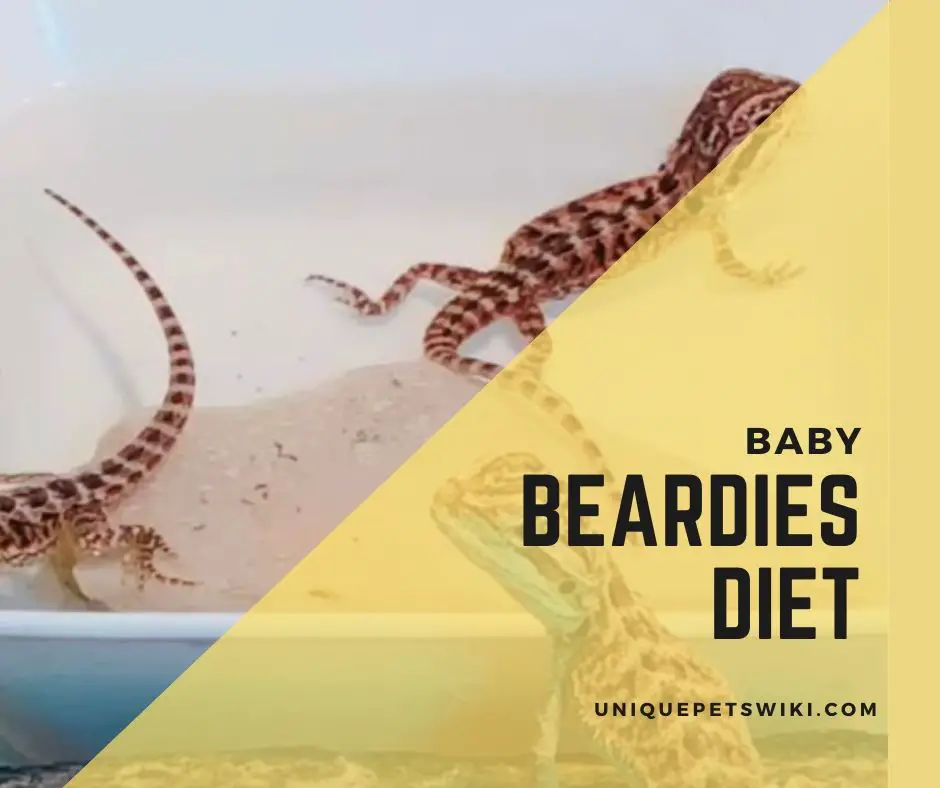
Now that you are fully aware of the foods that bearded dragons can eat, the primary concern now is which foods are ideal for feeding the baby beardies. The babies from hatchlings to four months old are at a critical stage where the beardie needs special care.
There is a rapid development of the body during this stage, and the pet needs high levels of proteins. So, which food will meet the high requirement of protein in babies? Just shortly, and you are going to see all the veggies, greens, insects, calcium, and vitamins to give the babies.
New to bearded dragon? Check out the bearded dragon care sheet now! We had listed out all the things you need to know about bearded dragons as pets. Check it now!
Babies Bearded Dragon Feeders
The primary thing to note is that baby beardies are in their initial stages of growth. They require high amounts of protein to develop fat reserves, build muscles, and body mass. It means that the babies have to take more insects than the plant matters.
Baby bearded dragon’s diet should comprise 60-80% meat (insects). Babies need to eat more frequently, around 4-5 times a day. Allow the babies bearded dragon between 0-2 months to eat as many crickets as they can within 5-10 minutes.
As the baby beardies grow, when around 3-4 months, feed them 3-4 times per day and let them consume as many crickets as they wish between 5-10 minutes. Such a time frame is enough for them to gather an adequate amount of protein that the body demands.
To avoid impaction, always ensure that the crickets you are giving to your beardie are smaller than the size of its eye.
Vegetables and Leafy Greens for Baby Bearded Dragons
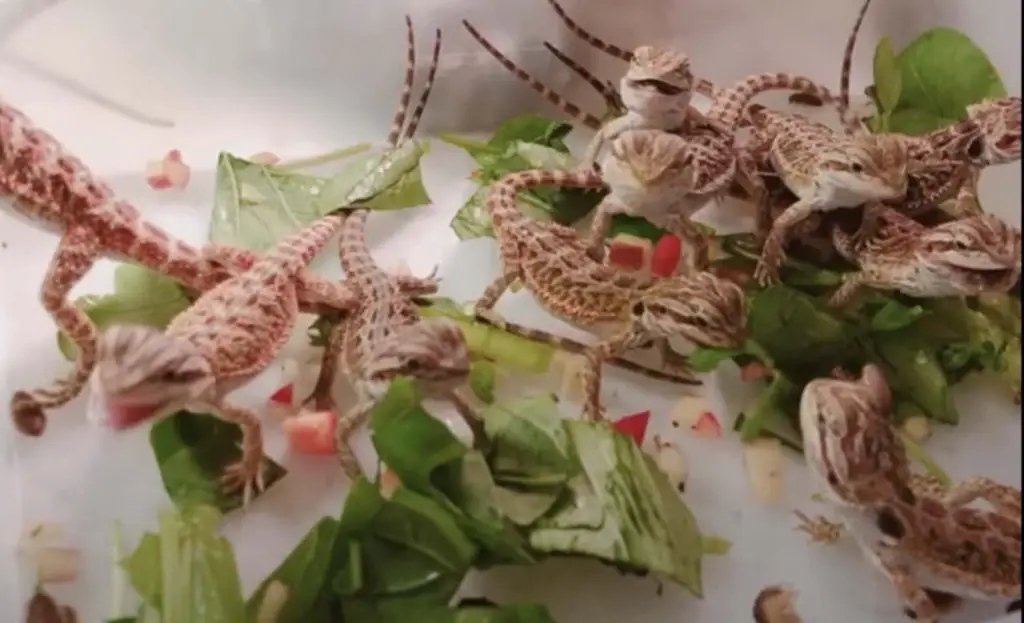
20-40% of the beardies’ diet is plant matter, which comprises the veggies, greens, and fruits. Most of the plant matter is greens and vegetables that make up to 80-90% part and fruits should only be 10-20%.
Baby beardies can eat a wide range of vegetables. All the vegetables that are dark green, leafy, yellow, red, and orange are safe to feed. Light green vegetables tend to be reduced in nutrients and vitamins and are rich in dietary fiber. Avoid them completely.
Here are some of the veggies and greens that are good for baby beardies-Mustard greens, red or green Cabbage, Bok choy, Collard green, Dandelion, Green beans, Bell Pepper, etc. Remove any food that will be remaining after 30 minutes, whether veggies or insects during feeding.
Does Baby Bearded Dragon Need Calcium? How Long Can They Go Before Getting Calcium?
Does a baby bearded dragon need calcium? Yes, the baby beardies need calcium for proper growth and bone formation. Baby bearded dragons need to have calcium in the diet about 5-7 times a week.
Insects cannot supply enough calcium, which the body needs; therefore, a calcium supplement is necessary. Dust your beardie’s diet with calcium infrequently during feeding.
Bearded dragons can go without calcium for two weeks. However, I don’t recommend you leave them such a long time without supplementing them with calcium. It can be more dangerous in case there is calcium deficiency.
Calcium and Vitamin for Baby Bearded Dragon
Calcium and vitamins are essential for multiple functions in baby beardies. Babies need higher amounts of calcium because they are actively growing. Dust its food with calcium supplement about five times weekly, each day one time.
In the remaining two days, drench the feeder with multivitamin mixed with calcium powder and don’t exceed one time per day.
Buy both calcium and vitamin supplements from a trustworthy and reputable seller. You can give calcium with vitamin D3 or not, depending on your pet’s exposure to UVA. With a sufficient amount of UVA, focus more on calcium without vitamin D3.
Juvenile Bearded Dragon Diet
Juveniles are baby adults that are 5-17 months old. The beardies are still growing during this stage, but they are growing slowly. You need to provide them with a well-balanced diet, but this time, the amount of protein is slightly lower as we are going to see.
It is during this period that you will gradually start to transition the beardie from dense protein feeders towards the adult diet rich in veggies.
Feeders for a Juvenile Baby Dragon
The juvenile diet is a composition of 50% insects and 50% plant matter. They are a little older, and you need to introduce minor changes from what you were feeding them before.
Between 5-9 months, let your juvenile beardies eat as many crickets as they will in a 5-10 minutes time frame, 2-3 times a day. As they get older from 9-12 months, leave them to eat as many crickets as they can manage in 5-10 minutes just two times each day.
When the beardie gets 12 months older, this is the right time to introduce them to the adult diet slowly. Start measuring a certain number of crickets instead of letting them consume as many crickets as they can. Feed them the set amount of the feeders twice in a day.
For example, if you usually feed 50 crickets daily, that is, 25 feeders every time you are feeding in the required two times per day, try and reduce the number. Give about 20 crickets in each feeding and feed twice daily. Increase the veggies and continue doing that for a couple of months until they get used to the food.
What If You Want to Feed Your Juvenile Other Feeders Beside Crickets?
If you want to feed your juvenile other protein sources besides cricket, I will still advise you to continue giving them their salad daily.
Check out the recommendation below on how to give a premium protein source to your juvenile beardie.
Juveniles between 4-9 months old.
- 8-12 Superworms once per day.
- Give 50-100 Black soldiers fly larvae per day.
- Provide 40-50 smaller nymph (0.5 inches) Dubias each day.
Juveniles that are nine months+ old.
- Feed them with 5-7 Superworms every other day.
- 50-75 Black soldier fly larvae daily
- 10-20 nymph (1 inch) Dubias daily.
Greens and Veggies for a Juvenile Bearded Dragon
It is during this stage when the amount of vegetable increases as the feeders reduces. From 5-9 months, you can continue using the ratio of 80:20 feeders and plant matter, respectively.
From there, start giving more greens in the diet, and try a variety of vegetables. When the beardie gets 12 months older, this time, it will be comfortable taking a 50:50 ratio of feeders and plant materials.
You will realize that some beardies adjust easily to taking vegetables while others require some more time. Whichever the case, get it right that no beardie is similar to another, each is unique in its way.
In case your beardie does not eat the veggies immediately, you can train them with the following secret tricks.
Start Training Your Beardies with Dried Food
How do I get my beardie to eat dried food? Bearded dragons will also consume dried food, as long as it is a beardie safe food. To get your beardie to eat dried food requires you to train them. But some beardies will comfortably eat dried food from the beginning.
It is more important to train your bearded dragon to eat dried food; they can be used as an alternative. The best thing about dried food is that they are easy to use because when you buy them, they are ready to eat. You can easily use them to feed the pet, especially when you are rushing for time.
When it comes to dried food, I recommend you to start training your bearded dragon when it is young. It helps the beardie to get used to the food from a young age. I have some secret tips to get your bearded dragon to eat dried food.
Calcium and Vitamins for a Juvenile Bearded Dragon
Juveniles need calcium in sufficient amounts for good health and great looking. Always ensure that your beardie at any stage has access to adequate calcium and vitamins. It prevents them from severe health issues like metabolic bone disease, among others.
Use the same amount of calcium you give the baby bearded dragons until the beardie reaches 12 months old. From there, reduce the calcium intake to three times every week, not more than once per day. Provide multivitamin once per week.
Continue with the amounts, and at the age of 18 months, you need to further reduce the intake of calcium to two times per week. It is still okay if you choose to give calcium three times, but not more than once in a day.
Adult Bearded Dragon Diet
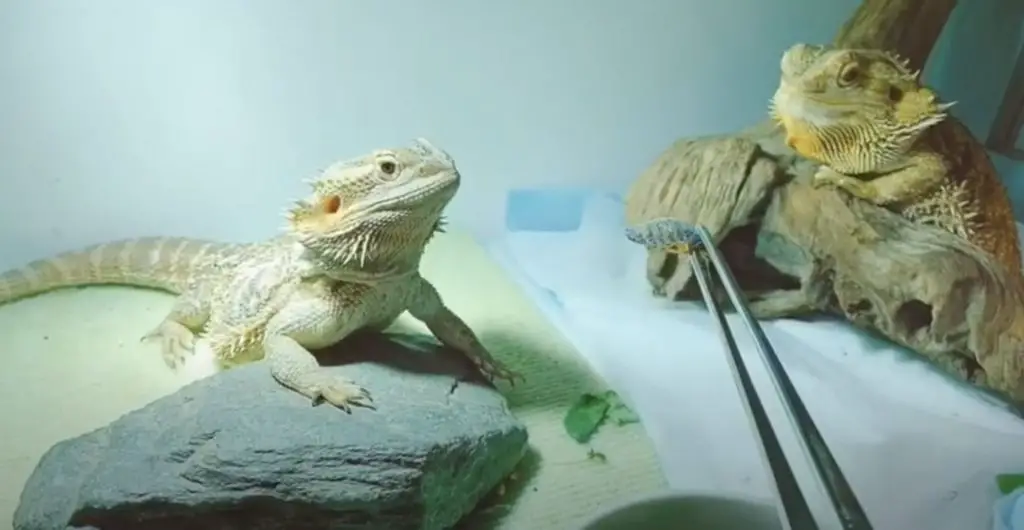
Adult bearded dragons need to eat well to stay healthy and for their wellness. They require more greens than the feeders, that is, 80 % plant matter and 20% insects. More protein can cause overweight and severe health issues in adults.
So, what do you need to feed your adult bearded dragon? With all the previous information, you are now aware that an adult beardie is one that is 18 months and above. There is no more growth when the beardie is 18 months old, it reaches at peak sexual maturity.
The foods I’m about to give will be ideal for feeding your beardie for the rest of its life. But the diet might change when the beardie is unwell. You will need to naturally adjust the food to meet your pet’s needs during that time.
Feeders for an Adult Bearded Dragon
Adult bearded dragons need a small number of insects, unlike the babies who are at their maximum growing stage. However, the adults still need feeders as their staple food.
The important point to note is that how many insects an adult can eat will depend on their body size. The beardies with large sized bodies can eat many crickets twice in a week than the smaller ones, and they still look healthy.
Below are the suggestions on how to feed feeders to the beardies. But you can adjust the levels depending on the size of your beardie.
- 7-10 Superworms every other day.
- Provide 3 to 5 large Dubias (2 inches) or 5 to 9 nymph Dubias (1 inch).
- Give ten crickets daily or 20 crickets every other day.
- 5-20 Black soldiers fly larvae per day included in another feeder.
Black soldier fly larvae can be used only as a treat because they are quite expensive. They are also full of calcium, don’t dust them.
Green and Veggies for an Adult Bearded Dragon
Just to repeat, an adult beardie’s diet should contain 80% greens and vegetables. The adults need to have a fresh salad every day, and I emphasize it is every day.
The adult bearded dragons eat a wide range of vegetables and greens. They will consume all the veggies I listed above on the bearded dragon diet list, at the beginning of this review.
Vegetables are a staple food to adult beardies; they provide vital minerals and vitamins. Adult beardies, most of the time, will obtain its water from the veggies and fruits.
Calcium and Vitamins for an Adult Bearded Dragon
Adult bearded dragons need calcium, but you can reduce the level to 2-3 times per week and give multivitamins once every week.
Dust their food with calcium only once in a day, please don’t exceed that. Too much calcium might be toxics to beardies and can cause hypercalcemia. Too low calcium is still dangerous; always make sure to give what is sufficient.
How Often Do Adult Bearded Dragons Eat?
Adult bearded dragons need to be fed at least once in a day, every day. They require fewer insects and more greens and vegetables. At this age, the beardie needs to feed to stay healthy. Too much feeding, especially with insects, can result in overweight and health issues.
However, skipping food for adults will not have much effect; they can survive for several days without food. But you really should make an effort to provide food to them once daily.
Bearded Dragon Feeding Schedule
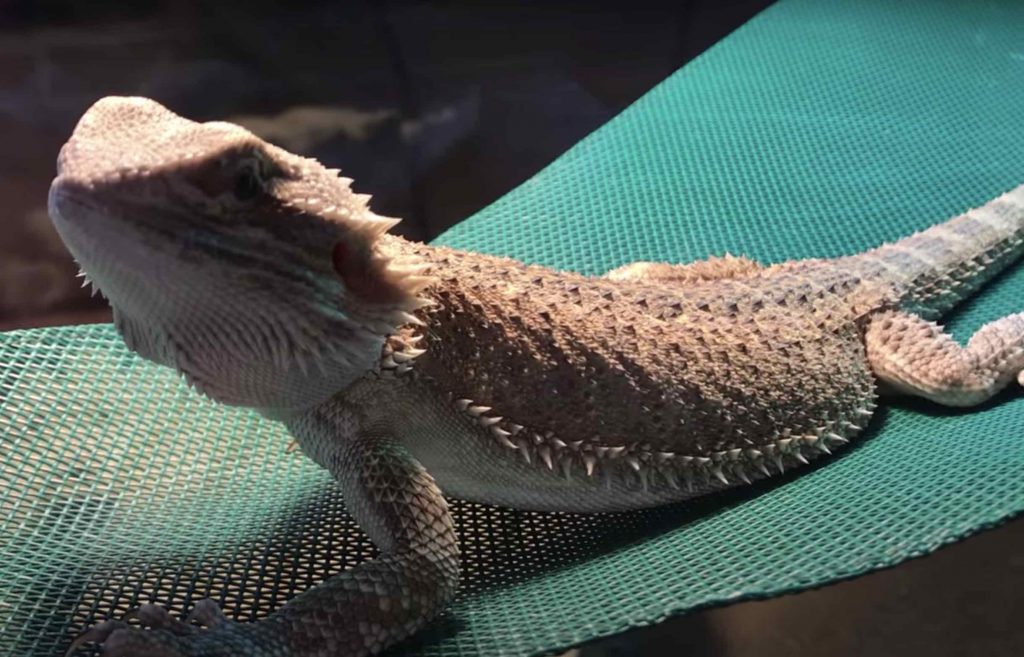
How often you feed your bearded dragon will depend on its age. Adults infrequently feed than the baby beardies.
Lighting is necessary when feeding the beardies, turn them on 30-60 minutes before feeding and leave them on when you are done with feeding for quite a long time. The lighting regime does not change among all the bearded dragons. It remains the same for adults and babies.
The beardies need to warm up so that they can get a healthy appetite for feeding. Lighting also allows the beardie to digest its food effectively. It also helps in the activation of Vitamin D3 that must be present for the absorption of calcium to take place.
Feeding the beardies when the temperatures in the enclosure are low, the food will not help them. It will be a waste. Then, after 30 mins or less when you are through with feeding, remove any food that is remaining. The beardies cannot eat them.
New to bearded dragon? Check out the bearded dragon care sheet now! We had listed out all the things you need to know about bearded dragons as pets. Check it now!
Leaving veggies and fruits behind can become sour and grow bacteria. Remaining feeders are even more threatening because they will bite your beardie. I know this is the last thing you want, please keep your beardie safe at all cost.
Adult Bearded Dragon Feeding Schedule

Feeding the adults beardies half of their food in the morning, and the other half at night is the best option.
Though in case you are such people who are not at home until it’s late due to the busy schedule, don’t worry. It is okay to feed your beardie one whole meal per day.
When using the second method of feeding, leave the food to stay a little bit longer before removing it. It allows the beardie to take as much food as they can, to sustain them until it is tomorrow.
Always ensure the lights are on 30 minutes before and after feeding to make sure that the food will be of benefit to the beardie.
Baby Bearded Dragon Feeding Schedule
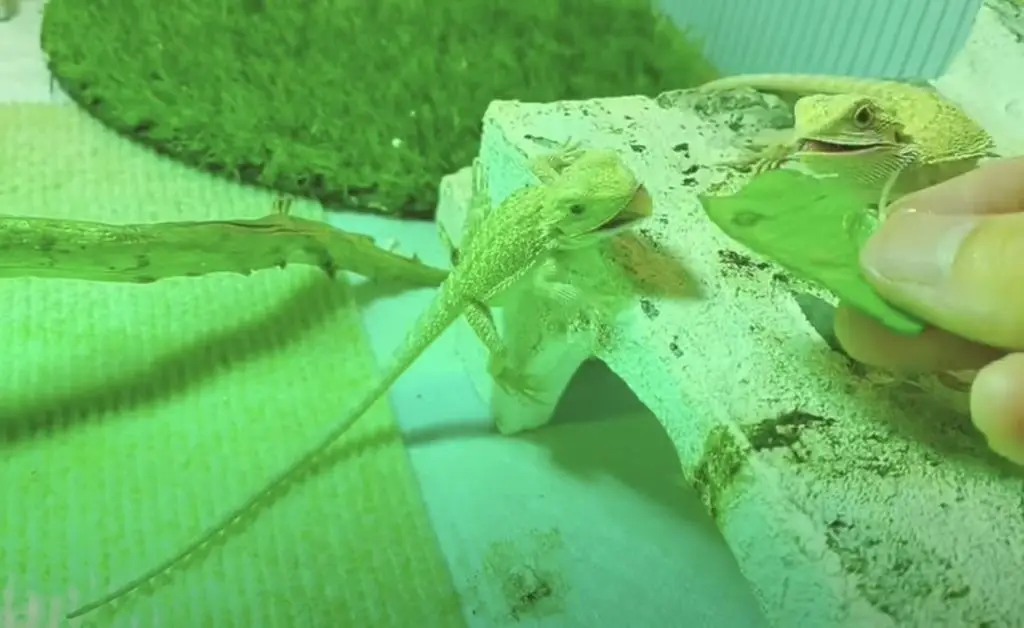
Young bearded dragons from 0-2 months require as many crickets as they can eat in 5-10 minutes, not less than 4-5 times daily. They should take approximately 50-60 crickets every single day.
The babies between 3-4 months need to take food 3 to 4 times a day. Let them eat as many crickets as possible in a 5-10 minutes time interval.
When the beardie is four months old, reduce the number of feedings to three times a day. Allow it to take as many crickets still as it can in a 5-10 minutes period. This should continue until they are about 8 or 9 months. After this, you will need to introduce them to the adult feeding schedule of two meals per day.
However, don’t stop pampering the beardie with protein for the next 7 to 10 months as it is still growing. But in case it turns out that the beardie is growing slower than normal, you can always adjust the staple amount of feeder in a day. Give the greens as often as it can take.
Bearded Dragon Diet by Age
Perhaps, it is clear to you that feeding varies in beardies depending on their ages, but I reiterate it for good reasons.
One major thing that is common in all beardies is that they must have access to feeders, vegetables, and fruits. Each of the ingredients has a significant function.
The young bearded dragons need higher volumes of proteins to enhance proper growth and body development. On the other hand, older beardies require fewer proteins and more vegetables to keep them healthy.
The primary difference between the adult and young beardies is the volume of protein in the diet. That is pretty clear now. The adult beardie can break down its fat reserves to supply them with energy. They don’t need much protein also because it can cause obesity.
How To Transition A Bearded Dragon To A New Diet
Bearded dragons can be stubborn when you are trying to make them eat what is not familiar to them. The truth is, you cannot introduce them to a new diet just once and expect them to appreciate it. You will only be destroying the beardie by projecting it more and more stress.
Transitioning the beardie to new food is easy now that you know when and why to change up its diet. Let me now expose you on how to transition a bearded dragon to a new diet.
When it is time to start changing your pet’s diet, do it gradually and allow the beardie more time to adapt to the new food. Easing the beardie into things causes them to continue growing as usual and prevents any complications.
Cut the protein in the beardie’s diet slowly between 9 to 12 months and gradually introduce more greens. Mix it up with vegetables and a few fruits here and there. It can take some time when you are still experimenting. Be patient with the beardie; it will eventually learn.
Beware that once the beardie gets used to good stuff such as Dubia roaches and Superworms, this can be the end of them taking crickets. This means that it may be challenging when it comes to eating the greens. You need to act smart to prevent such situations.
If your beardie doesn’t accept the new diet even after multiple trials, don’t worry. Bearded dragon salad dressing is here to help you with that. It stimulates the bearded dragons to eat every greens and vegetable in the diet, no matter how stubborn they seem.
Buy this great product from Amazon, and watch your beardie devouring on the greens.
How Long Can A Bearded Dragon Go Without Food?
How long a bearded dragon can go without food will vary depending on the age. Some of the variables that can make a beardie refuse to eat are stress, incorrect temperature, illness, a new diet, a new environment, etc.
Adult bearded dragons can go up to two months without food. They depend on their body fat reserves, which are broken to supply the energy to sustain the beardie.
However, I don’t recommend you to keep your pet without food. Adults need to feed at least once in a day to stay healthy.
The baby bearded dragons are in their fast growth stage; they need everyday nourishment to keep them growing. If they miss the food, even a single day, it can cause health problems.
What Not To Feed Your Bearded Dragon
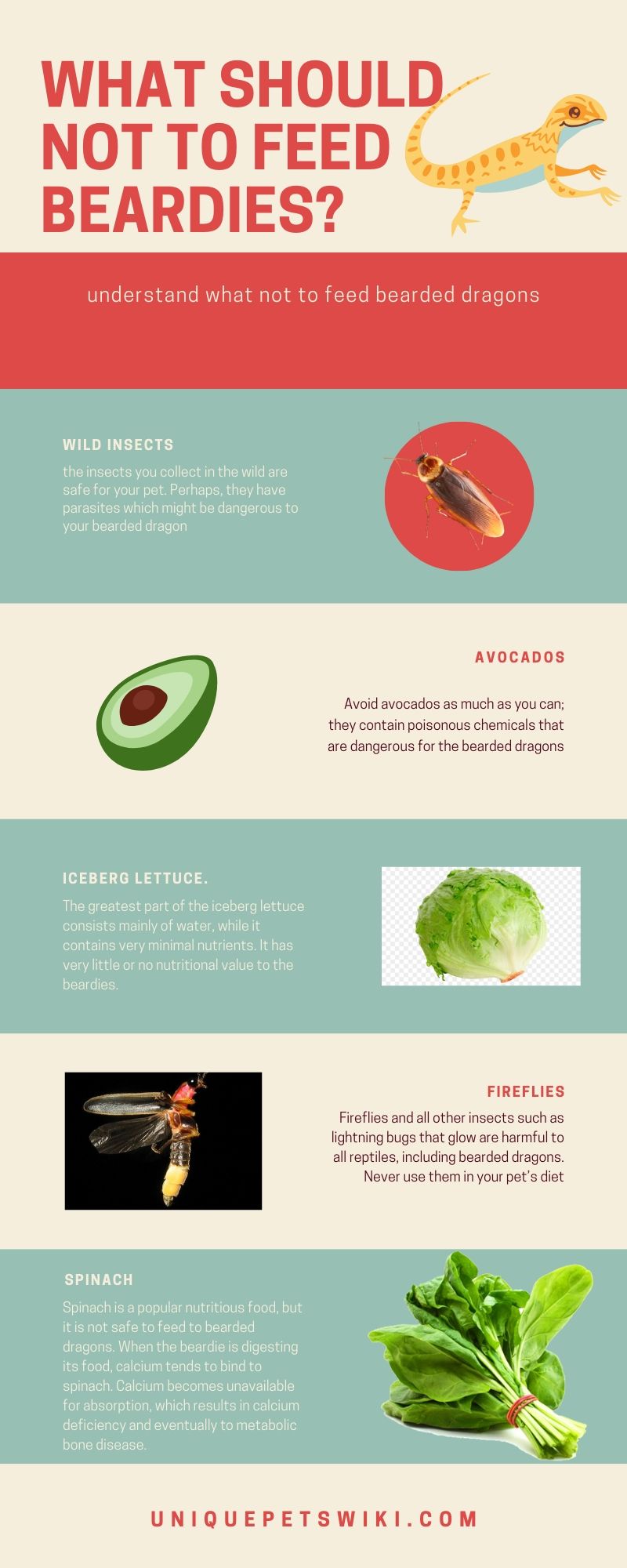
There are those foods that you should altogether avoid feeding your beardie because they can be toxic or have no nutritional value.
Here is the list of the foods that under no circumstances should you ever feed them to any bearded dragon.
- Spinach.
- Lettuce.
- Avocados.
- Fireflies.
- Beet tops.
- Fish and seafood.
- Bran and wheat.
- Buttercup.
- Wild-caught insects.
- Rhubarb.
- Avoid Dairy products such as cheese, milk, ice cream, etc.
- Avoid Meat (poultry, red meat, etc.).
- Fern.
- Daffodil.
A good rule of thumb: If you are not sure whether the food is approved for beardies or not, please avoid and avoid it at all cost.
Wrapping Up Bearded Dragon Diet
Now, there you have it. I hope you found this article to be impactful in teaching you all about the bearded dragon diet, when to feed and what not to feed.
I know it is a great challenge when you have the beardie there with you, and you don’t know how much food to accurately feed them. It is even more confusing when it comes to changing their diet as they get older.
The worst thing is when you buy a bearded dragon’s food only to find out that your pet does not even look at it. It is truly annoying.
But now you are safe to know that finding a staple food that makes your beardie happy requires some patience and time. After a little experiment, you will surely find the food that your dear pet enjoys.
